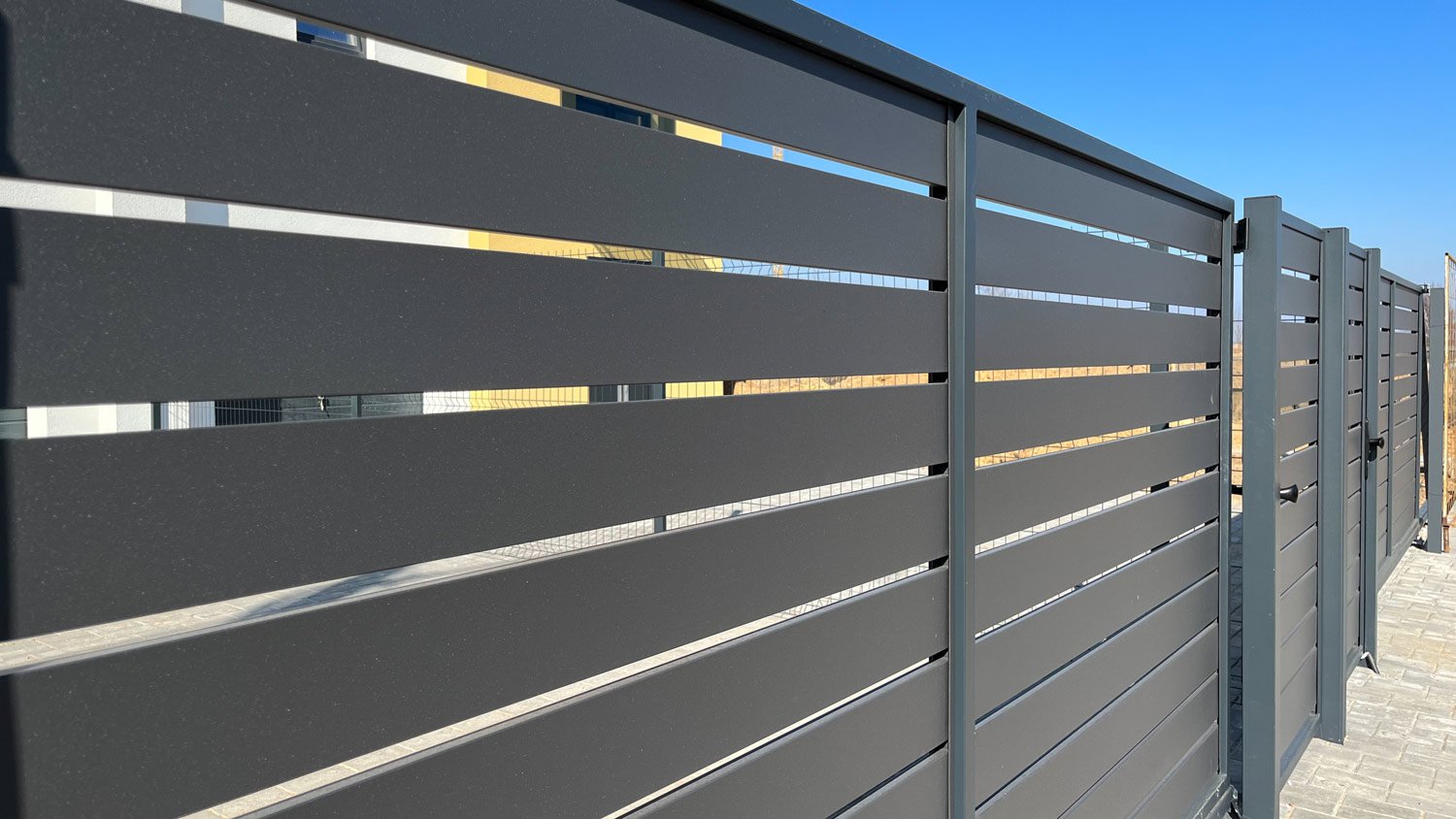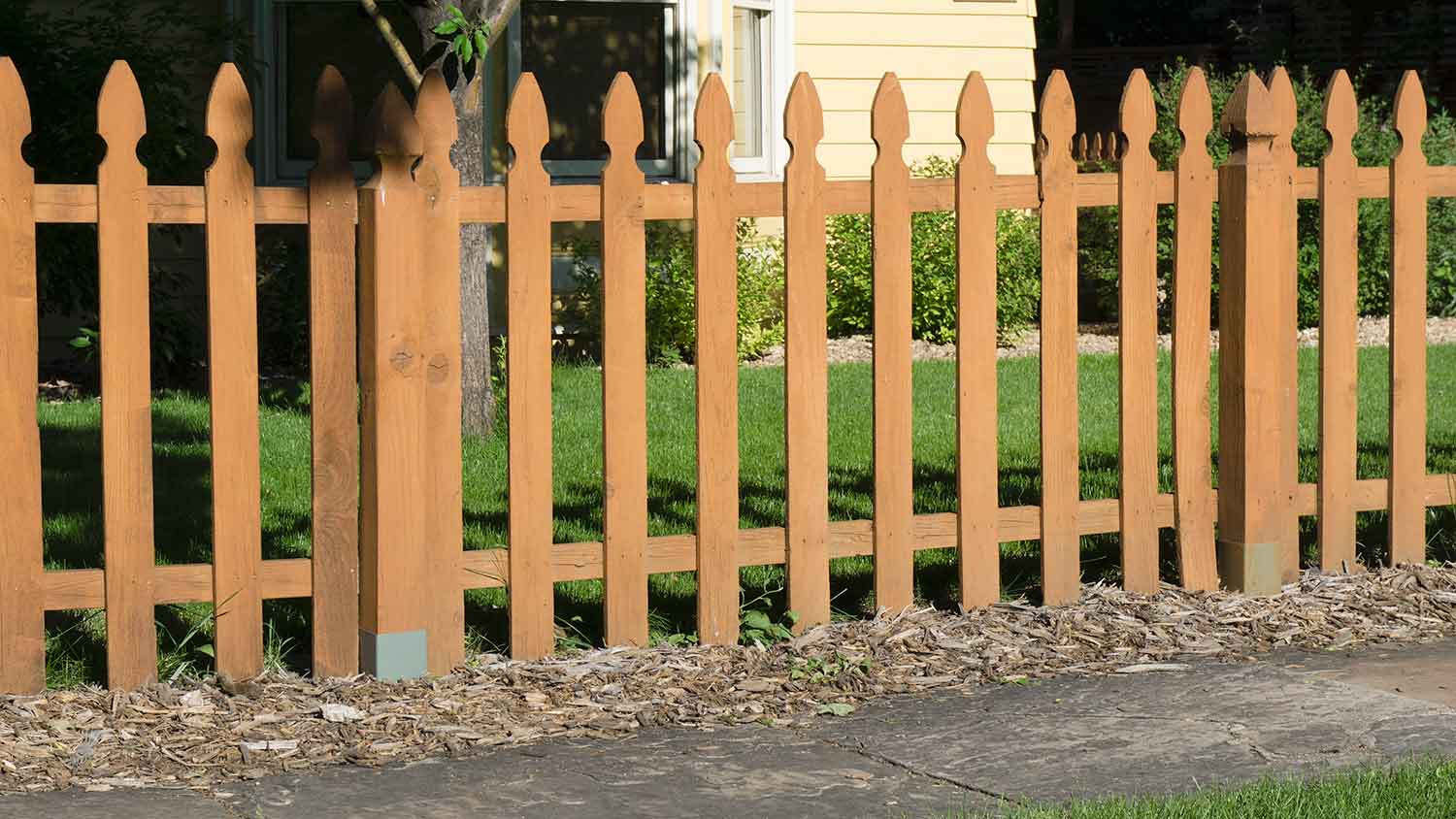Vinyl vs. Aluminum Fences: Pros, Cons, and Costs
Gear up for a fencing material face-off


Both fencing materials feature similar benefits but vary in style and design.
Durability, low maintenance, and ease of repair are among the pros of vinyl and aluminum fencing.
Vinyl and aluminum fencing boasts longevity of upward of 20 years.
Many homeowners compare vinyl vs. aluminum fencing because both materials reign supreme in their benefits. Whether you prioritize classic aesthetics, low maintenance, or long-term sustainability, this guide will help you choose between these two popular fencing material options.
Vinyl vs. Aluminum Fencing: Key Differences
Vinyl and aluminum are popular choices for homeowners seeking long-lasting and low-maintenance fencing options. The primary distinction between the two is the material used, which gives each unique qualities that make it suitable for different situations. Vinyl fences are made from PVC and are resistant to moisture, rot, and insects. They come in various colors and styles and require minimal upkeep.
Aluminum fences offer a modern and sleek appearance because they are constructed from rust-resistant metal. While aluminum fencing is more expensive upfront, it's durable and can withstand various climates. Due to their lightweight nature, aluminum fences are easier to install than vinyl fences, which may require more effort. Ultimately, the choice between vinyl and aluminum fencing depends on factors such as budget, maintenance requirements, and aesthetic preferences.
What Is a Vinyl Fence?

Vinyl fencing is made from polyvinyl chloride (PVC), a synthetic plastic material known for its durability and resistance to environmental factors like sun, rain, and insects. The fencing is designed to mimic the appearance of traditional wood fences but requires minimal maintenance and no painting or staining. This makes vinyl an attractive choice for homeowners seeking a long-lasting and low-maintenance fencing option. Vinyl fences come in various styles, colors, and textures, allowing homeowners to customize their outdoor spaces.
| Pros | Cons |
|---|---|
| Durable | High installation cost |
| Low maintenance | Limited repair options |
| Long lifespan | Sensitive to high temperature |
| Weather resistant | Requires pro installation |
| Variety of styles | Not biodegradable |
Best for:
Homeowners looking for low-maintenance fencing.
Regions with diverse weather conditions.
Locations prone to insect infestations.
Pros of Vinyl Fencing
Vinyl fencing is a popular choice among homeowners due to its exceptional durability. The material easily resists rot, decay, and insect damage, making it well-suited for different climates. Vinyl fencing's ability to withstand harsh weather conditions, such as rain, snow, and UV rays, adds to its appeal and makes it an excellent choice for outdoor environments.
For homeowners looking for an easy-to-manage fence, vinyl requires minimal maintenance, with only occasional cleaning needed to keep it looking good. The wide variety of styles, colors, and textures available with vinyl fencing allows homeowners to customize their fences to their liking and match the architecture of their homes. The long lifespan of vinyl fences, often accompanied by warranties, ensures they are a reliable and long-lasting option for properties.
Cons of Vinyl Fencing
Despite the many benefits of using vinyl fencing, there are certain drawbacks. One issue is the upfront cost, which can be higher than other fencing materials. Although there are DIY options available, hiring a local vinyl fence installer will ensure proper alignment and stability for a successful and lasting fence.
While a good option for areas with rain and snow, locations with extreme temperatures are at a disadvantage because the fences become less flexible and can warp or crack. Repairing damaged sections of vinyl fencing can pose a challenge because entire panels may need to be replaced, which means added costs. Another disadvantage is the environmental impact of vinyl, which is not biodegradable and raises concerns about its long-term sustainability and contribution to plastic waste.
What Is an Aluminum Fence?

Aluminum fencing is a corrosion-resistant, lightweight fence made from aluminum metal. This modern fencing solution is durable and low-maintenance, making it a popular choice for property boundaries. Aluminum's rust resistance suits different climates, and its lightweight quality makes installation easier. With a range of styles available, homeowners can choose the aluminum fencing best suited for them. While the initial cost may be higher than some other fence styles, the long-term benefits of aluminum fencing make it an attractive option.
| Pros | Cons |
|---|---|
| Durable | High upfront cost |
| Low maintenance | Less privacy |
| Lightweight | Not ideal for security |
| Variety of styles | Limited color options |
Best for:
Homeowners looking for a sleek and modern design for their outdoor fencing.
Regions where climate resistance is paramount.
DIY-ing fence installation due to its lightweight feature.
Pros of Aluminum Fencing
The durability and corrosion resistance of aluminum fencing make it a top choice for outdoor use. Its low-maintenance qualities are also notable, requiring minimal upkeep due to its rust and fade resistance. A sleek and modern aesthetic adds to the appeal, with a variety of styles and designs available to suit any home's architecture. The lightweight construction of aluminum contributes to easy handling during installation and cost-effectiveness, including its DIY-ability.
Cons of Aluminum Fencing
One common concern about using aluminum fencing is that despite clearly marking boundaries, it doesn't offer the same level of privacy as vinyl or wood. Similarly, aluminum is less suitable for those with high-security needs because it's lightweight and more susceptible to damage and forced entry.
While aluminum fencing boasts various shade options, its range of color options is limited. Using this material may also have higher upfront costs than other options.
Aluminum vs. Vinyl Fencing
Appearance: Tie
Vinyl and aluminum can look beautiful, so which is best depends on your taste. Vinyl fencing is known for its ability to imitate traditional wood and offers a classic, warm appearance. Aluminum fencing is revered for its sleek and modern design, providing a contemporary and sophisticated look to any outdoor space.
Options and Customization: Vinyl
While both vinyl and aluminum offer many selections from style to colors to textures, vinyl is the leading option because it has more to choose from. Aluminum fencing can be limited, specifically in terms of color range, which could make it difficult to find exactly the shade you're looking for.
Durability: Tie
Vinyl and aluminum fencing boast high durability, however, each has different properties it helps protect against. Vinyl's resistance to rot, decay, and insects, along with its low maintenance requirements, make it an excellent option for climates of varying conditions. Aluminum's exceptional corrosion resistance and rust protection make it a suitable choice for regions with harsh weather conditions. Although both materials are low-maintenance, aluminum's specific corrosion resistance gives it a slight advantage in durability.
Price: Vinyl
While vinyl and aluminum tend to be higher-cost fencing options than wood or chain link, vinyl is the more cost-effective choice. Vinyl fence costs range between $2,300 and $5,800, while an aluminum fence cost will be slightly higher, averaging between $2,430 and $6,500.
Ease of Installation: Aluminum
Aluminum's lightweight quality makes it easy to install because handling the components, including posts and panels, requires minimal physical effort. Aluminum fencing often showcases innovative designs and quick-connect mechanisms that simplify the assembly process. Installing an aluminum fence can boast labor cost savings for an intermediate to advanced DIYer.
Whether you want to learn how to install aluminum fence or even how to install vinyl fence, some expertise is recommended to ensure proper alignment and stability. Areas with varying terrains or specific design requirements call for a fencing pro.
Ease of Repair: Tie
Vinyl and aluminum fences typically have similar repair styles. When damaged, it's likely whole panels will require replacement rather than using other repair techniques. Common repairs aluminum fences require are repairing hinges or removing rust and corrosion, which are relatively simple tasks.
Maintenance: Vinyl
Both vinyl and aluminum fencing are highly regarded for their low-maintenance properties, but vinyl takes the lead in terms of ease of upkeep. With its exceptional resistance to rot, decay, and pests, as well as its lack of need for painting or staining, vinyl fencing requires very little maintenance. Simply cleaning it on occasion is usually sufficient to keep it looking good. Aluminum fencing also requires minimal upkeep due to its rust resistance, but it may need periodic cleaning to prevent oxidation.
Length of Life: Tie
Both vinyl and aluminum have similar lifespans, each averaging around 20 years. Vinyl siding can last up to 30 years, but aluminum, if well-cared for, could last up to 50 years. Either way, both options are great for homeowners seeking longevity in their investments.
Sustainability: Aluminum
Aluminum is a recyclable metal, making it a more sustainable option. Recycled aluminum retains its properties, reducing the need for raw material extraction and energy consumption. The material can be recycled at the end of its lifespan, contributing to a more environmentally friendly life cycle. Vinyl fencing tends to be less environmentally friendly because it's a synthetic material made from PVC (polyvinyl chloride), which raises concerns about its environmental impact during production and disposal. The manufacturing process of PVC involves the use of non-renewable resources, and the material itself is not biodegradable.





- The Pros and Cons of Vinyl Fencing—Is There a Preference for PVC?
- Vinyl vs. Aluminum Windows: Which Should You Choose?
- How Long Does a Vinyl Fence Last?
- Vinyl vs. Wood Fences: Pros, Cons, and Costs
- Vinyl vs. Aluminum Soffit: Which Should You Choose?
- 8 Types of Metal Fences for Yards, Pools, and More
- Which Is Best for Your Home: Vinyl vs. Aluminum Gutters
- 8 Best Fences for Dogs: Pros and Cons of Every Option
- Aluminum vs. Vinyl Siding: A Comparison Guide
- Chain Link Fence vs. Wood Fence: Pros, Cons, Costs










